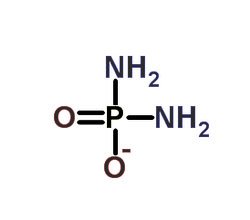Missing link of primeval soup found?
Phosphorus compound could have created three crucially vital components
Three at one stroke: A small phosphorus compound could have been the crucial prerequisite for first life on Earth, because this chemical was able to synthesize three major biomolecules: Nucleotides as precursors of RNA and DNA, Peptides as protein precursors and Lipids for the envelope membranes of the first cells. Thus, the molecule called Phosphorodiamidate was possibly the key to the development of the first cells.

A molecule could have helped in the formation of three important life molecules. © Natalia Kollegova / pixabayOne thing is clear: at about 3.5 billion years ago, the first living cells must have appeared on Earth. But where and how this happened is still puzzling. For example, the first RNA and DNA building blocks could have been formed by lightning or brought to Earth by comets. However, how these building blocks became chain-shaped genetic molecules and how the first proteins were formed from amino acids is just as unclear as the formation of the first cell envelopes from lipids.
Obstacle phosphorylation
One of the reasons: All these biomolecules require a special chemical reaction for their formation, the so-called Phosphorylation. However, all of the candidate reactants would only have worked in one of these three basic classes of life molecules, or they would need very specific environmental conditions incompatible with primordial soup.
It is therefore hard to imagine how these very different reaction processes should have taken place in one place to form the first primitive life forms, explains Ramanarayanan Krishnamurthy of the Scripps Research Institute at La Jolla.
It would be much more obvious that there was a molecule in the primordial soup that could phosphorylate all three substance classes. But such an "all-rounder" has been sought in vain.
One molecule - three effects
Now, however, Krishnamurthy and his colleagues may have found just this missing molecule. As they found in experiments, the phosphorus-nitrogen compound phosphorodiamidate (H4N2O2P) can react with a wide range of biomolecule building blocks and assemble them into larger chains. What is needed is only an aqueous solution of the building blocks and the catalyst Imidazole, a simple organic compound that was most likely present in primordial soup.
For example, if the phosphorodiamidate is added to a solution containing the four nucleotide bases of the RNA, it phosphorylates it and joins it into short RNA chains, the researchers report. The phosphorodiamidate also combines single fatty acids and glycerine to lipids with similar efficiency.
We were surprised to see that even large vesicles with lipid bilayer formed, report Krishnamurthy and his colleagues.
And even with the third important class of molecules of life, the phosphorus compound reacted - with amino acids. In the experiment, it combined the amino acids glycine, aspartic acid and glutamic acid by phosphorylation into short peptide chains.
Obstetrician of first life?
With that, the researchers could finally have discovered the actor which co-created the most important life molecules.
It almost reminds me a little bit of the fairy, who wields her wand in the fairytale Cinderella, turning simple everyday objects into something more complex and interesting, says Krishnamurthy. This phosphorylation agent could then have created both oligonucleotides and oligopeptides and the cell-like structures that included them in one place.
Thus only the phosphorodiamidate would have created the conditions under which the first life could form. Whether phosphorodiamidate was actually present in primeval soup, however, is likely to be difficult to prove after more than 3.5 billion years. But at least the scientists think it is very likely - also because this molecule can work under aqueous conditions and in a wide range of temperatures.
Echo of primordial soup chemistry still in our cells
At least there is some evidence that the necessary building blocks were present for those on the primeval Earth.
Astronomers have discovered evidence for phosphorus-nitrogen compounds in the gas and dust of interstellar space, says Krishnamurthy. It is therefore very plausible that such compounds were also present on the early Earth and played a role in the formation of complex life molecules.
In addition: until today, the phosphorylation of molecules in our cells takes place in a very similar way as by the Phosphorodiamidate - even if the actors are now different.
Thus, phosphorodiamidate phosphorylates by the same breakage of phosphorus-nitrogen bonds and under the same conditions as protein kinases, says Krishnamurthy. And at the heart of each cell's metabolic cycle, chemistry is quite similar to that of phosphorodiamidate.
Source: Nature Chemistry, 2017; doi: 10.1038 / nchem.2878


wow you get great information i was never know it even i try to learn i can't go so deep as you go and get great content .. it's just amazing appreciate man ☺
Thank you! Never give up with being interested in something. ;-)
yap you right keep it up bro
upvote and follow brother
Thanks!
it's my plesure
img credz: pixabay.com
Nice, you got a 53.0% @nasgu upgoat, thanks to @n3bul4
Want a boost? Minnowbooster's got your back!
The @OriginalWorks bot has determined this post by @n3bul4 to be original material and upvoted(1.5%) it!
To call @OriginalWorks, simply reply to any post with @originalworks or !originalworks in your message!
Congratulations! This post has been upvoted from the communal account, @minnowsupport, by n3bul4 from the Minnow Support Project. It's a witness project run by aggroed, ausbitbank, teamsteem, theprophet0, someguy123, neoxian, followbtcnews/crimsonclad, and netuoso. The goal is to help Steemit grow by supporting Minnows and creating a social network. Please find us in the Peace, Abundance, and Liberty Network (PALnet) Discord Channel. It's a completely public and open space to all members of the Steemit community who voluntarily choose to be there.
This wonderful post has received a bellyrub 13.57 % upvote from @bellyrub. Please make sure to vote for my pops as a witness @zeartul,Here
This post has received a 6.57 % upvote from @booster thanks to: @n3bul4.